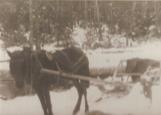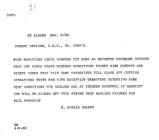1
By the early 1900's, harvesting timber for pulpwood became an increasingly more important aspect of the regional economy. The harvesting of pulpwood essentially involved three distinct activities and was governed by seasonal climatic variations.3
The first of these activities was the actual harvesting or cutting of the timber which was carried out in the fall (September and November and, in some cases, into December). The next phase entailed what was referred to as the "haul off", commencing in January and continuing until mid March. The timber would be hauled from the cutting site to be piled on frozen lakes and rivers in preparation for the spring "drive". The haul off was carried out utilizing horse and sled and, in some cases, oxen would be used.5
How successful this phase was depended on weather conditions during that period. Camps were responsible for ensuring that their own cuts were transported to the nearest waterway. In order to accommodate this activity, they depended on hard frost and snow to facilitate transporting the timber. Mild conditions could delay this activity and, in some cases, prevent camps from getting all of their timber out.8
The third or last phase of the operations was referred to as the "drive" which essentially meant getting the wood out for transport to its final destination. In the Bay d'Espoir region, the drive would be carried out on Southeast Head Bay d'Espoir River, Main Conne River, Southeast Conne River and Little River. The men would dam off the river, when the ice melted and it was time to float the logs down the river they would let the dams go, forcing the logs downstream. Once the timber reached the mouth of these waterways, it was loaded on ships and transported to the paper mill in Corner Brook.10
Some of the earliest activity related to pulpwood harvesting in the Bay d'Espoir region began with the establishment of the St. Alban's Co-operative Society in 1922. Under this society, members cut and shipped pulpwood to Sorel, Newport News and Portland. This activity carried on between 1922 and 1932. In addition to the export of pulpwood, the Bay d'Espoir region exported "pit props" which were used as temporary roof supports in long wall mines. The vast majority of pit props were exported overseas.11
In 1910, Roland Clement Goodyear, his father Josiah and his brothers Joe and Stan established a diversified business that involved numerous activities which included contract logging as well as freight handling, and a taxi service among other interests. By 1923 the business was incorporated as J. Goodyear & Sons and expanded into general contracting and road construction. In the late 1930's, Roland also became involved with the Island Timber Company located in St. Alban's. The Island Timber Company was one of the first companies to begin harvesting pulpwood in the Bay d'Espoir region. The Directors of Island Timber Company were: C.A. Crosbie, President; C.A. Pippy, Secretary Treasurer; and R.C. Goodyear, Managing Director.13
The Island Timber Company engaged in pulpwood harvesting in the area between 1937 and 1940 cutting some 43,000 cords of pulpwood for export. The operation employed up to 250 men operating out of 5 camps. One of these camps was sub-contracted to a local sawmiller, J.W. Kendell, from Morrisville.14
Extract from letter R. F. Dove to E. R. Bearns, dated August 11th, 1937"Our employees are insured under the N.M.A.M. Insurance Association Limited, which in the event of injuries sustained by employees covers the periods of treatment and convalescence at half-time or $1.25 ($1.00) per day. Cost of treatment and medical material are covered under the arrangements as contracted for between the Company and the service inaugurated by the Board of Health under the Boards representation at Harbour Breton, and for which service a deduction is made of 40¢ which amount is paid by cheque to the Chairman of the Board of Health at the end of each month." (R. F. Dove was the manager of Island Timber Co. and E. R. Bearns was the Forest Inspector.)





